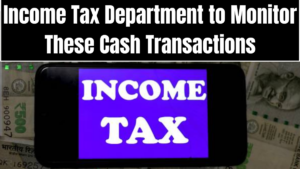The Income Tax Department is tightening its grip on unreported income and unfiled returns, especially when it comes to high-value cash transactions. In April 2025, the department has doubled down on efforts to detect suspicious financial activity by working closely with banks, post offices, co-operative societies, fintech platforms, and mutual fund houses.
By leveraging data analytics and collaborating with other government bodies, the department can now track high spenders who haven’t filed ITRs or have underreported income. Institutions are required to report qualifying transactions via Form 61A or 61B by May 31 of the following financial year.

What Are High-Value Transactions?
High-value transactions are those that cross specific monetary thresholds and must be reported to the Income Tax Department. Here’s a breakdown of such transactions:
| Sr. No. | Transaction Description | Threshold (INR) | Reporting Entity |
|---|---|---|---|
| 1 | Cash payments for bank drafts, pay orders, or RBI instruments | ₹10,00,000 | Banks / Co-operative Societies |
| 2 | Cash deposits in savings account | ₹10,00,000 | Banks, Co-operative Societies, Postmasters |
| 3 | Cash deposits or withdrawals from current account | ₹50,00,000 | Banks / Co-operative Societies |
| 4 | Purchase or sale of immovable property | ₹30,00,000 | Property Registrar / Sub-registrar |
| 5 | Investment in shares, bonds, or mutual funds in cash | ₹10,00,000 | Issuing companies / Mutual fund houses |
| 6 | Payment of credit card bill in cash | ₹1,00,000 | Banks / Co-operative Societies |
| 7 | Payment of credit card bill other than in cash | ₹10,00,000 | Banks / Co-operative Societies |
| 8 | Foreign currency sale or expenses via Forex card | ₹10,00,000 | Authorized Dealers under FEMA |
| 9 | Cash deposits in FDs or RDs | ₹10,00,000 | Banks, Co-operatives, NBFCs, Nidhi Co. |
Measures Taken by the Department to Track These Transactions
1. Upgraded Form 26AS and AIS
The Department now includes Specified Financial Transactions (SFT) in Form 26AS and has launched the Annual Information Statement (AIS) to display financial activity, helping taxpayers cross-verify their data.
2. TDS on Cash Withdrawals
Cash withdrawals exceeding ₹1 crore in a year will incur 2% TDS, and if ITR hasn’t been filed in the last three years, TDS of 5% applies beyond ₹1 crore and 2% beyond ₹20 lakh.
3. Mandatory ITR Filing for Certain Transactions
Even if total income is below ₹2.5 lakh, individuals must file ITR if:
-
Cash deposits in current accounts exceed ₹1 crore
-
Foreign travel expenses exceed ₹2 lakh
-
Electricity bills exceed ₹1 lakh
What to Do If Form 26AS Shows SFT Transactions
If you spot SFT entries in Form 26AS, make sure to:
-
Confirm their accuracy
-
Report them in your ITR
-
Pay the appropriate taxes to avoid notices or scrutiny
E-Campaign for Voluntary Compliance
To ease compliance, the IT Department has launched an e-campaign focusing on:
-
Non-filers of ITR
-
Incorrect or mismatched returns
This campaign involves sending email/SMS alerts to taxpayers based on third-party data from SFT, TDS, GST, and investment platforms.
Who Receives Email or SMS in This Campaign?
The campaign targets:
-
Individuals who haven’t filed ITR
-
Taxpayers with mismatches between their returns and AIS/Form 26AS
Even if you’ve filed your return, you must submit feedback if you receive such notice.
How to Comply With the E-Campaign and Submit Response
Step-by-Step Guide:
-
Login to your income tax e-filing account
-
Navigate to: ‘Pending Actions’ > Compliance Portal > ‘e-Campaign (AY 2021-22 onwards)’
-
Select the relevant campaign
-
Choose the information category (marked ‘e’)
-
Select the transaction marked as ‘Expected’
-
Submit your response by choosing one of the following:
-
Information is correct
-
Not fully correct
-
Income not taxable
-
Relates to other PAN/year
-
Duplicate or already included
-
Denied
-
Preliminary Response in the Compliance Portal
The portal also requires users to submit a Preliminary Response, especially in cases of:
-
High-value transactions
-
Non-filing of ITR
Steps:
-
Click ‘Provide Response’
-
Respond using the dropdown
-
Add extra details like Acknowledgement Number, ITR date, and filing mode
-
Submit and download a copy from the ‘Activity History’
Importance of Using the Compliance Portal
Using the portal helps you:
-
Avoid tax notices
-
Confirm AIS information
-
Comply digitally without visiting tax offices
Timely and accurate responses ensure you remain compliant and responsible. Your inputs help the Income Tax Department reduce tax evasion and boost the nation’s economy.
FAQs
What is an SFT transaction?
SFT stands for Statement of Financial Transaction. It’s used to report high-value financial activities to the tax department.
What happens if I ignore an e-campaign notice?
Ignoring a notice may result in a tax notice, scrutiny, or penalty. You must respond promptly using the compliance portal.
Can I correct errors in AIS?
Yes. You can provide feedback in the AIS section of your account to correct or dispute any incorrect data.
Is ITR mandatory if I have no income but high-value transactions?
Yes. If you’ve performed specified transactions (like ₹1 crore in deposits or ₹2 lakh in foreign travel), ITR filing is mandatory.
What is the deadline for institutions to report SFT transactions?
All reporting entities must submit details of high-value transactions by May 31 of the following financial year.
Click here to know more.
Aanchal is a passionate writer with a keen interest in storytelling, content creation, and creative expression. She enjoys exploring diverse topics and crafting engaging narratives that captivate readers.

